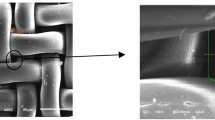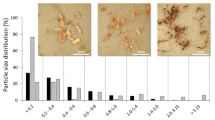Abstract
Purpose
Valorization of pine needles by producing briquettes and identification of optimum levels of densification process parameters based on physical, handling and combustion properties.
Methods
Experiments were conducted based on orthogonal array test with 16 sets of experiment for 4 levels of 3 independent parameters, size of pine needles, densification pressure and temperature. The briquettes of 35 mm diameter were prepared using a steel mould with well smashed pine needles at 10% (wet basis) moisture content. The dependent parameters were, change in volume, density, durability and compressive strength of briquettes. Grey relational analysis was conducted to identify the optimum levels of independent parameters that minimized the percent change in volume and density of briquettes, and maximized the durability and compressive strength. Grey relational grade that gave equal importance to all the dependent parameters was used as the index for the identification of optimum solution.
Results
The pine needles of particle size less than 2 mm, pressure of 9 MPa and temperature of 150 °C was found to be optimum for the production of briquettes, with densification pressure having the highest influence on quality of briquettes. The briquettes produced had calorific value of 17.56 MJ kg−1, density of 1228 kg m−3 and compressive strength of 7.05 MPa. The briquettes were used in an updraft gasifier to generate producer gas which had calorific value of 4.24 MJ Nm−3. It took 12 min to produce flammable gas. The gas from the gasifier can be burnt using specially designed burners in furnaces.
Conclusions
The optimum briquetting process parameters identified can be used for the large scale production of briquettes from pine needles at the industrial scale. This will add value to the pine needles, and reduce the risk of forest fire, carbon emissions, greenhouse gas effects and the environmental pollution to a great extent.
Graphical Abstract




Similar content being viewed by others
References
Singh, R.D., Gumber, S., Tewari, P., Singh, S.P.: Nature of forest fires in Uttarakhand: frequency, size and seasonal patterns in relation to pre-monsoonal environment. Curr. Sci. 111(2), 398–403 (2016)
Dwivedi, R.K., Singh, R.P., Bhattacharya, T.K.: Studies on bio-pretreatment of pine needles for sustainable energy thereby preventing wild forest fires. Curr. Sci. 111(2), 388–394 (2016)
Font, R., Conesa, J.A., Moltó, J., Muñoz, M.: Kinetics of pyrolysis and combustion of pine needles and cones. J. Anal. Appl. Pyrolysis. 85(1), 276–286 (2009)
Panwar, V., Prasad, B., Wasewar, K.L.: Biomass residue briquetting and characterization. J. Energy Eng. (2016). https://doi.org/10.1061/(ASCE)EY.1943-7897.0000040
Singh, R.N., Bhoi, P.R., Patel, S.R.: Modification of commercial briquetting machine to produce 35 mm diameter briquettes suitable for gasification and combustion. Renew. Energy 32(3), 474–479 (2007)
Granada, E., López González, L.M., Míguez, J.L., Moran, J.: Fuel lignocellulosic briquettes, die design and products study. Renew. Energy 27(4), 561–573 (2002)
Adapa, P., Tabil, L., Schoenau, G.: Compaction characteristics of barley, canola, oat and wheat straw. Biosyst. Eng. 104(3), 335–344 (2009)
Wamukonya, L., Jenkins, B.: Durability relaxation of sawdust and wheat-straw briquettes as possible fuels for Kenya. Biomass Bioener. 8, 175–179 (1995)
Yaman, S., Şahan, M., Haykiri-açma, H., Şeşen, K., Küçükbayrak, S.: Production of fuel briquettes from olive refuse and paper mill waste. Fuel Process. Technol. 68, 23–31 (2000)
Chin, O.C., Siddiqui, K.M.: Characteristics of some biomass briquettes prepared under modest die pressures. Biomass Bioener. 18, 223–228 (2000)
Li, Y., Liu, H.: High-pressure densification of wood residues to form an upgraded fuel. Biomass Bioener. 19, 177–186 (2000)
Wilaipon, P.: Physical characteristics of maize cob briquette under moderate die pressure. Am. J. Appl. Sci. 4(12), 995–998 (2007)
Chou, C.S., Lin, S.H., Peng, C.C., Lu, W.C.: The optimum conditions for preparing solid fuel briquette of rice straw by a piston-mold process using the Taguchi method. Fuel Process. Technol. 90(7), 1041–1046 (2009)
Stolarski, M.J., Szczukowski, S., Tworkowski, J., Krzyżaniak, M., Gulczyński, P., Mleczek, M.: Comparison of quality and production cost of briquettes made from agricultural and forest origin biomass. Renew. Energy 57, 20–26 (2013)
Zhang, X., Xu, D., Xu, Z., Cheng, Q.: The effect of different treatment conditions on biomass binder preparation for lignite briquette. Fuel Process. Technol. 73(3), 185–196 (2001)
Rhén, C., Gref, R., Sjöström, M., Wästerlund, I.: Effects of raw material moisture content, densification pressure and temperature on some properties of Norway spruce pellets. Fuel Process. Technol. 87, 11–16 (2005)
Mani, S., Tabil, L.G., Sokhansanj, S.: Effects of compressive force, particle size and moisture content on mechanical properties of biomass pellets from grasses. Biomass Bioener. 30, 648–654 (2006)
Marsh, R., Griffiths, A.J., Williams, K.P., Wilcox, S.J.: Physical and thermal properties of extruded refuse derived fuel. Fuel Process. Technol. 88, 701–706 (2007)
Kaliyan, N., Morey, R.V.: Factors affecting strength and durability of densified biomass products. Biomass Bioener. 33(3), 337–359 (2009)
Lin, C.L., Lin, J.L.: Optimisation of the EDM process based on the orthogonal array with fuzzy logic and grey relational analysis method. Int. J. Adv. Manuf. 19, 271–277 (2002)
Moran, J.C., Miguez, J.L., Porteiro, J., Patin˜o, D., Granada, E., Collazo, J.: Study of the feasibility of mixing refuse derived fuels with wood pellets through the grey and fuzzy theory. Renew. Energy 34, 2607–2612 (2006)
Wang, H., Jiang, X., Liu, J., Lin, W.: Experiment and grey relational analysis of CWS spheres combustion in a fluidized bed. Energy Fuels. 21(4), 1924–1930 (2007)
Moran, J.C., Granada, E., Miguez, J.L., Porteiro, J.: Use of grey relational analysis to assess and optimize small biomass boilers. Fuel Process. Technol. 87(2), 123–127 (2009)
Kaliyan, N., Morey, R.V.: Factors affecting strength and durability of densified products. Proceedings of American society of agricultural and biological engineering annual international meeting, American society of agricultural and biological engineers, Portland, Oregon, July 9–12, Paper Number 066077, 2950 Niles Road, St. Joseph, MI pp. 49085–9659, USA: (2006)
Lin, L., Yan, R., Liu, Y., Jiang, W.: In-depth investigation of enzymatic hydrolysis of biomass wastes based on three major components: cellulose, hemicellulose and lignin. Bioresour. Technol. 101(21), 8217–8223 (2010)
Grover, P.D., Mishra, S.K.: Biomass briquetting: technology and practices. Regional wood energy development program in Asia, Field Document No. 46. Bangkok, 19 Thailand: Food and Agriculture Organization of the United Nations; (1996)
Mani, S., Tabil, L.G., Sokhansanj, S.: Evaluation of compaction equations applied to four biomass species. Can. Biosyst. Eng. 46(3), 55–61 (2004)
van Dam, J.E.G., van den Oever, M.J.A., Teunissen, W., Keijsers, E.R.P., Peralta, A.G.: Process for production of high density/high performance binderless boards from whole coconut husk part 1: lignin as intrinsic thermosetting binder resin. Ind. Crops Prod. 19, 207–216 (2004)
Sakkampang, C., Wongwuttanasatian, T.: Design of briquettizing machine for biomass briquette fuel. Adv. Sci. Lett. 13(1), 565–569 (2012)
Author information
Authors and Affiliations
Corresponding author
Rights and permissions
About this article
Cite this article
Mandal, S., Prasanna Kumar, G.V., Bhattacharya, T.K. et al. Briquetting of Pine Needles (Pinus roxburgii) and Their Physical, Handling and Combustion Properties. Waste Biomass Valor 10, 2415–2424 (2019). https://doi.org/10.1007/s12649-018-0239-4
Received:
Accepted:
Published:
Issue Date:
DOI: https://doi.org/10.1007/s12649-018-0239-4




